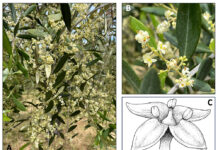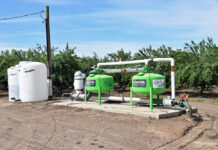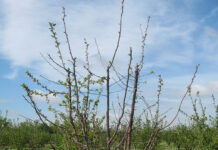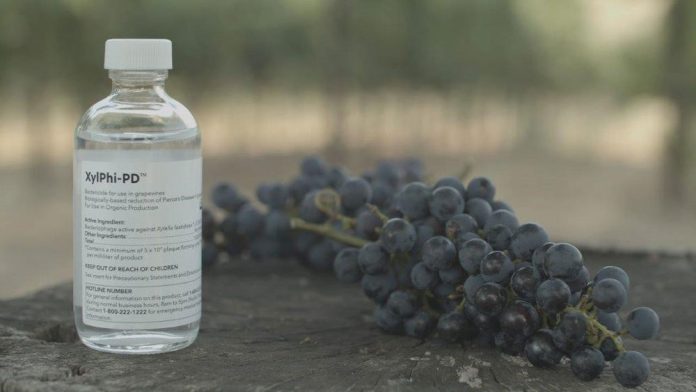Though vineyard managers continually face many challenges to optimal productivity, Pierce’s Disease (PD) represents a particularly formidable threat due to limited options for effective prevention and control. PD is a degenerative, deadly and costly disease of grapevines caused by Xylella fastidiosa subsp. fastidiosa (Xff) bacteria, Gram-negative rod-shaped microbes with characteristic large pili. Though hosted by many plant species, these bacteria are easily spread to grapevines by insect vectors such as blue-green and glassy-winged sharpshooters (Figure 1, see page 41). Xff colonize the gut of sharpshooters and are transmitted to grapevines as the insects feed on vines.
Pierce’s Disease: A Major Threat
Once inside a grapevine, Xff bacteria impede the normal function of xylem tissue (transport of water and nutrients ‘up’ from roots to stems and leaves.) This damage induces the characteristic chlorosis and scorching of leaves, causing early symptoms of PD which mimic water stress. However, the insidious and cumulative damage caused by PD eventually kills entire vines in one to five years.

PD represents a major threat to U.S. wine regions, accounting for widespread economic damage (e.g., roguing and replanting of vines, low fruit production, etc.) and costly deployment of resources aimed at disease moderation. PD has been reported in 28 California counties, covering most of all wine-producing regions. State Extension teams in Texas, Arizona and North Carolina have reported significant outbreaks in 2021. Lost production and vine replacement has been estimated to cost grape producers about $56.1 million annually as of 2014. Further, a 2016 survey of nearly 200 growers and managers in Napa and Sonoma counties revealed that 73% of respondents identified PD was one of their top three management problems.
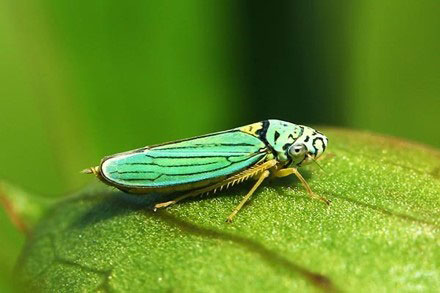
Few methods for controlling and treating PD have been made available, with efforts historically focused on controlling the sharpshooter vector (e.g., insecticides, trapping, monitoring, inspections) or roguing seriously ill vines (rogue, replant), all of which has achieved only limited success. However, a new option that reduces PD in grapevines is now available.
New Bacteriophage Injection for PD
XylPhi-PD is a novel, OMRI-listed, biological treatment for PD, a cost-effective break-through technology developed exclusively for viticulture by A&P Inphatec (Figure 2, see page 32). XylPhi-PD contains a cocktail of viral bacteriophages (Figure 3, see page 32) that are injected into a grapevine (‘bacteriophage’ are bacteria-killing viruses that selectively infect bacteria but do not infect the eukaryotic cells of plants or animals.) These virus particles enter and destroy Xff bacteria, thus limiting bacterial growth and the xylem-clogging damage to the plant. Hundreds of phage particles can be manufactured inside an Xff bacterial cell after infection by a single phage particle. The Xff bacterial cell eventually dies and releases all newly created phage particles to seek and destroy more Xff bacterial cells (Figure 4).
XylPhi-PD applications are made by injection of the product into the vascular system of grapevines. Applications are made directly into the active xylem tissue of the plant using a pressurized injection device, the Xyleject Injection System (Figure 5).
XylPhi-PD can be flexibly applied as a treatment when disease symptoms appear, as a preventative to protect growing vines, or whenever conditions may lead to disease. As with most any disease situation, disease prevention or treatment early in the disease process provides much better outcomes than treatment of later-stage severe infections. XylPhi-PD is available in 100-mL vials (treats up to 300 mature vines or 600 young vines.) The product has no restricted-entry interval (REI), requires minimal personal protective equipment (PPE) when used in accordance with label directions and is approved for use in organic production (OMRI-listed, Organic Materials Review Institute).
Efficacy Overview
Multiple studies have been conducted to support the development and commercialization of XylPhi-PD, and results have provided much insight regarding the product’s efficacy profile and use strategies. Brief overviews of some of these studies follow:
Greenhouse pilot study (Texas A&M, 2014):
Design: 30 greenhouse grapevines inoculated with Xff. 15 vines treated with XylPhi-PD once at three weeks post-inoculation, 15 vines received only buffer. Visual symptoms of PD assessed 12 weeks post-inoculation.
Results: XylPhi-PD reduced PD incidence by 87%.
Natural infection field trial (Texas A&M, 2015):
Design: 30 Chardonnay and 30 Cabernet Sauvignon vines in an area with high natural PD pressure randomly assigned to each of the four groups. Vines treated zero, one, two or three times with XylPhi-PD during the summer.
Results: Disease incidence in the XylPhi-PD-3X group was significantly reduced by 44% (P = 0.047) compared to controls (10% vs 18%). Activity of vectors positive for Xff was high during the trial period.

Challenge studies, prevention and therapeutic treatment (California University, 2017):
Design: Prevention study – 15 Chardonnay and 15 Cabernet Sauvignon vines treated with XylPhi-PD and then challenged twice with Xff.
Therapeutic study – 30 Chardonnay and 30 Cabernet Sauvignon vines/group challenged twice with Xff and then treated zero, one, two or three times with XylPhi-PD.
Results: Prevention – prechallenge XylPhi-PD significantly reduced incidence of PD symptoms by 75% in Cabernet Sauvignon vines (P < 0.10) and 100% in Chardonnay vines (P < 0.05) vs controls.

Therapeutic – three post-challenge XylPhi-PD treatments significantly reduced incidence of PD symptoms by 90% in Cabernet Sauvignon vines (P < 0.05) and 77% in Chardonnay vines (P < 0.10) vs controls.
Multi-year natural infection field trial (2017-20; Sonoma, Calif.):
Design: Two groups of healthy Zinfandel vines were tracked in a high PD-pressure, organic vineyard for three seasons (Ridge, Lytton Springs). One group (n=71) received XylPhi-PD three times/summer, while controls (n=94) only received buffer.
Results: After three years of treatment, vines treated with XylPhi-PD show much less PD incidence than control vines as assessed by both qPCR (-60%) and visual PD symptoms (-72%). Vines treated with XylPhi-PD also generated higher fruit yields, averaging +1.34 lb/vine (+21%) more than control vines.
4-site, 3-year, Natural Infection Field Trial (2019-21; Sonoma, Calif.):
Design: A three-year, multi-location commercial (Wilbur-Ellis) field study evaluated the efficacy of XylPhi-PD against endemic PD across four sites and three production seasons. The extensive research effort began in 2019 when a study was conducted that involved 400 vines (300 Chardonnay, 100 Pinot Noir) at three Sonoma County commercial wineries with a history of PD (one winery had two test fields) (Figure 6). All four commercial vineyards were historically high PD sites, and despite continual roguing and insecticide use in the past, a persistent reservoir of Xff remained in the vineyards from previous infection cycles. Thus, each site included vines with both early-stage and chronic/severe PD.

Vines were randomly selected in treatment blocks at each site and assigned to either of two treatment groups as follows:
-Control (untreated): n=200 (50/site);
-XylPhi-PD: three treatments (Jun/Jul/Aug); 80 µL of XylPhi-PD injected twice in the trunk and once in each cordon (4 to 6 injections = one treatment); n=200 (50/site).
Six petioles from each vine were collected in September for analysis by quantitative polymerase chain reaction (qPCR) and confirmation of Xff infection. All study vines were also visually assessed by trained observers for PD development. Insect traps were placed at each study site in an attempt to monitor vector pressure.
A continuation of the same study protocol was followed in 2020 and 2021, allowing two additional seasons of treatments and observations for the same vines/blocks at the same sites/wineries. In addition, treatments and observations of additional vines were initiated in 2020 at each site (n=50/site, 200 total), repeated again in 2021 (Figure 7). As a result, three groups emerged from the study for tracking and evaluation:

Vines with three years of treatment (three-year treated, n=200)
Vines with two years of treatment (two-year treated, n=200)
Non-treated controls (n=200)
Results
Comparative outcomes for vines qPCR-positive for Xff are summarized in Figure 8, see page 36. Under the conditions of only mild to moderate PD pressure and low vector populations, sequential year-to-year use of XylPhi-PD generated impressive results. Incidence of Xff positivity fell 24% and 45%, respectively, for vines receiving two or three years of treatment compared to untreated controls. Improvement in the three-year group was significant (P < 0.05) vs controls. The few vines remaining Xff-positive in the two- and three-year groups were chronic infections that would be rogued.

The visual assessment of vines for signs of PD was another important study parameter, and outcomes (Figure 8) were similar to those using qPCR confirmation of infection. Vines treated with XylPhi-PD for two years generated a 27% reduction in visual PD incidence compared to controls, while vines treated for three years showed double the benefit, a significant 54% reduction (P < 0.05) of PD incidence. The similarity of these data with qPCR results suggests that visual assessments can help vineyard managers tangibly gauge the efficacy of XylPhi-PD.

Notably, XylPhi-PD continued to protect against PD infections at all four trial sites for the three years of observations, with no new infections detected in the three-year treated group. In contrast, the control group had ~2% to 4% new infections.
Fruit yield was measured at one study site (D) at the study’s conclusion in 2021 (Figure 9, Chardonnay, eight- to ten-year-old vines). Compared to untreated controls, vines in the group treated with XylPhi-PD for three years averaged 5.1 lb (+17%) more fruit per vine than controls. Vines treated for two years were intermediate (3.1 lb, +10% more fruit vs controls).
Usage Recommendations
XylPhi-PD can be applied as a preventive treatment to protect growing vines, as a therapeutic treatment when disease symptoms become visible, or anytime production conditions may lead to disease pressure.
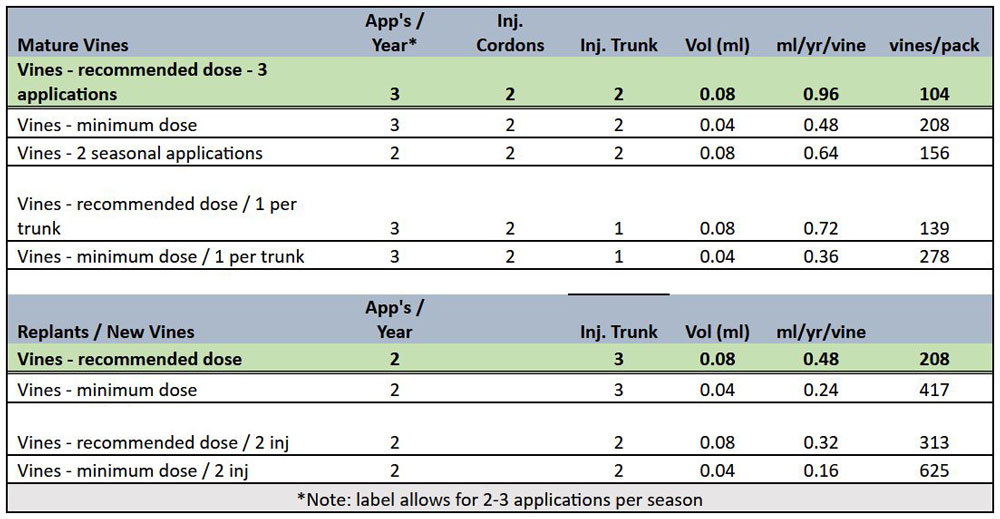
Locations selected for application of XylPhi-PD can be based on the age of the plant, the pruning style and/or the training system utilized for the plant. The product is to be injected into the active xylem vascular tissue above ground level. Two examples of injection strategies appear in Figure 10, see page 37. On established vines, for example, one or two injections can be applied in the trunk with an additional injection in each cordon or spur. For young, recently planted or radically pruned vines, apply two or three injections into shoot, two to six inches above the ground. For all scenarios, the total number of injections administered to a vine define one ‘application’ of XylPhi-PD.

For most production situations (medium to high PD pressure), two or three applications of XylPhi-PD are recommended during each growing season at near-monthly intervals (Figure 11, see page 37). This frequency of application has been demonstrated to provide optimal PD control under various levels of PD pressure. The volume of XylPhi-PD administered can also vary depending on the age of plants being treated and PD pressure.

The quantity of XylPhi-PD used in XylPhi-PD treatment programs can vary based on the number of injections/vine, the concentration of product/injection and the number of applications/year. Growers and PCAs have options and flexibility to match doses and the number of applications to their specific conditions and risks. Table 1 summarizes some of these options and their impact on the amount of XylPhi-PD used and number of vines treated per 100-mL vial.
Treatment Strategies for PD Management
Several recommendations for managing PD across an entire vineyard have emerged from field use experience with XylPhi-PD. These recommendations largely depend on the scope and distribution of PD in a particular vineyard or block.
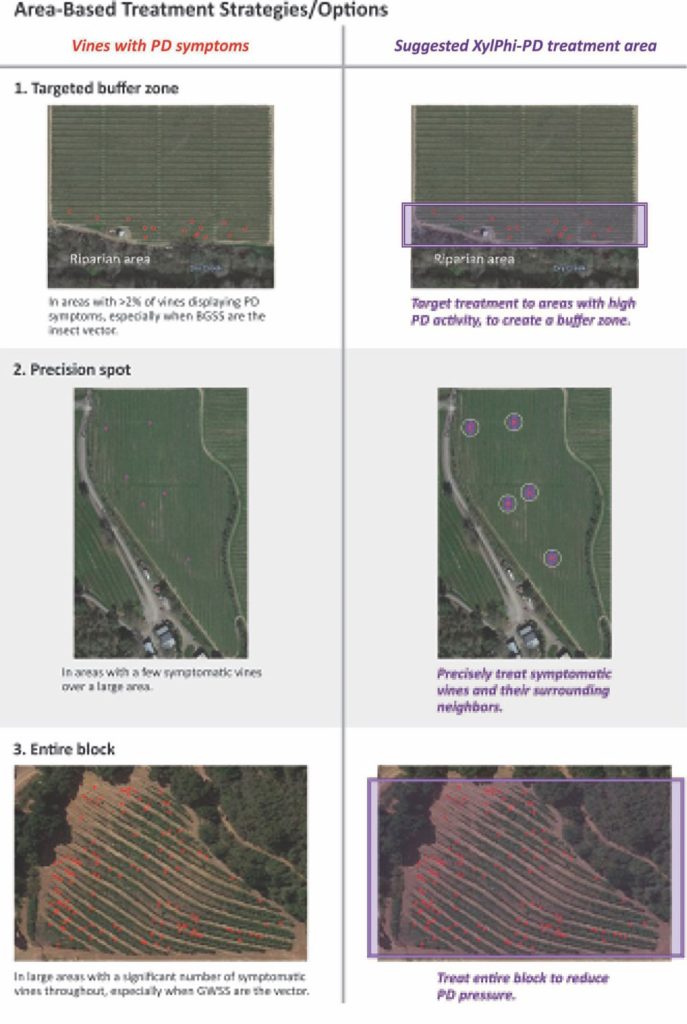
As usual, vines demonstrating severe and/or chronic PD infection should be rogued per IPM protocols.
Vines appropriate for XylPhi-PD treatment should be identified.
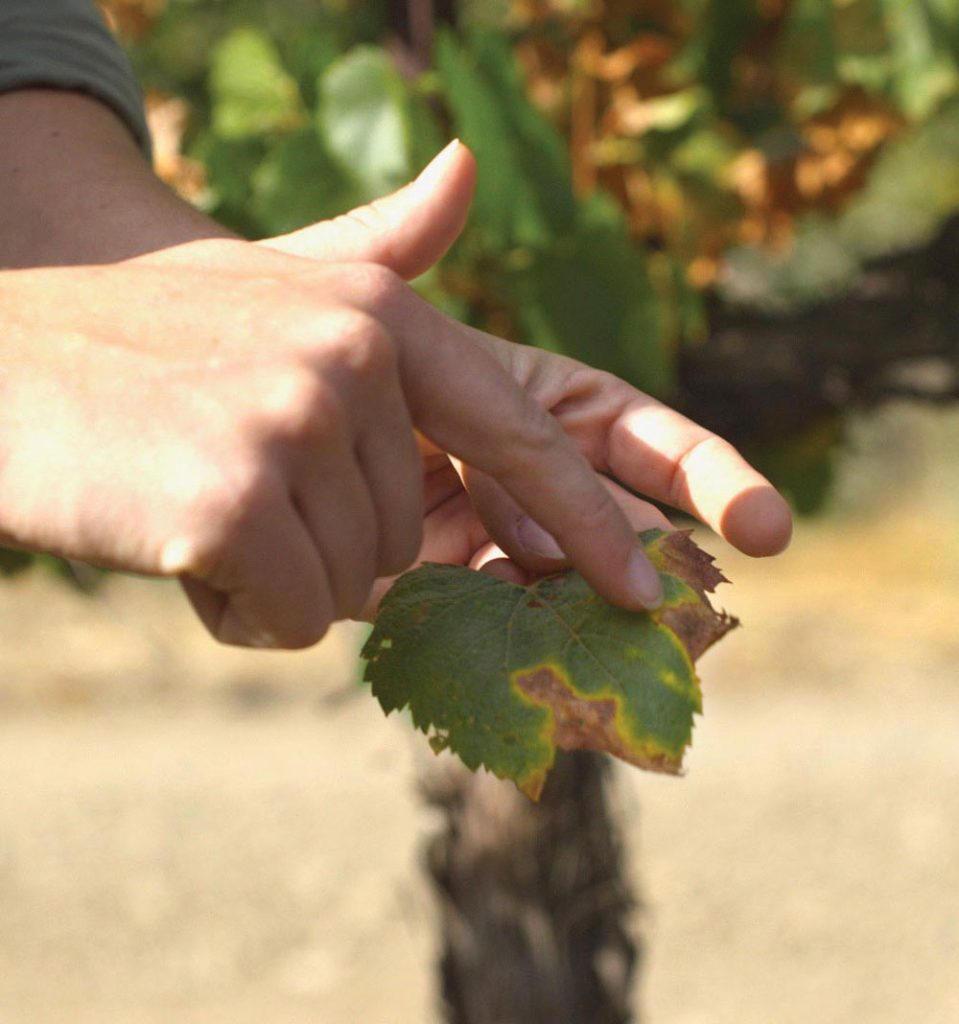
These appropriate vines should be treated with recommended doses of XylPhi-PD at two or three seasonal applications as needed for mature vines or replants (per label directions).
It is the second step, identifying which vines to treat, that can sometimes pose a quandary for production managers. To help in this process, three strategic options can offer direction for developing a customized plan for vineyard-wide PD management. Based on evaluations regarding the spread of infection and site specifics for a particular vineyard or block, a treatment strategy can be selected from the following (Figure 12):
Targeted buffer zone: Treat all vines in any defined area with high PD activity (>2% symptomatic vines) and/or vector activity, such as near a riparian area.
Precision spot: In large areas with few symptomatic vines, mark/identify affected vines and treat only them and their immediate surrounding neighbors.
Entire block: In large areas with multiple scattered symptomatic vines, in the presence of vectors, full-block treatment is needed to reduce overall PD pressure.
In addition to these three options, the duration of treatment (multiple years) is also a critical consideration. As discussed earlier, field studies have demonstrated the cumulative value of consistent treatment with XylPhi-PD over multiple years for reducing the level of PD in a vineyard or block, even when under low PD pressure. As always, prevention of severe, chronic disease is the best approach, and consistent long-duration use of XylPhi-PD appears to substantially diminish PD progression and pressure in vineyards.
Identifying PD
Some of the visual signs of PD damage are presented in Figure 13, including characteristic chlorosis (leaf scorching), irregular lignification and berry shriveling, and ‘matchstick’ petioles. In general, PD is likely present in a vineyard if the following four symptoms are observed late in the season:
Leaves scald in concentric rings or in sections
Leaf blades abscise, leaving petioles attached to the cane
Bark matures irregularly
Fruit clusters shrivel or raisin
However, damage caused by various other diseases, water stress, pests or nutrient deficiencies/imbalances may produce symptoms similar to those caused by PD. Therefore, PD must be laboratory confirmed by detection of Xff by qPCR testing on late-season/fall petioles (e.g., UC Davis Foundation Plant Services, Texas Plant Disease Diagnostic Lab, Arizona Plant Diagnostic Network).
Conclusions
PD is an extremely challenging problem for wine producers and their consultants. A biological control approach with XylPhi-PD offers a fresh opportunity to help manage PD and limit losses associated with the disease. In multiple studies, XylPhi-PD treatment of diverse wine varietals prompted reductions in PD incidence and/or severity under conditions of both natural and challenge infection with Xff. These favorable outcomes distinguish XylPhi-PD as a targeted and cost-effective strategy for effectively protecting valuable vineyards against PD.
Always read and follow product label directions. Not registered in all states. EPA Reg. No. 93909-1. Operators of injector must undergo training and be certified by Pulse and must follow instructions in device manual. XylPhi-PD is a trademark of A&P Inphatec. Xyleject is a trademark of Pulse Biotech.
To view a field trial demonstration click here https://www.youtube.com/watch?v=LzwQv-hfcew


